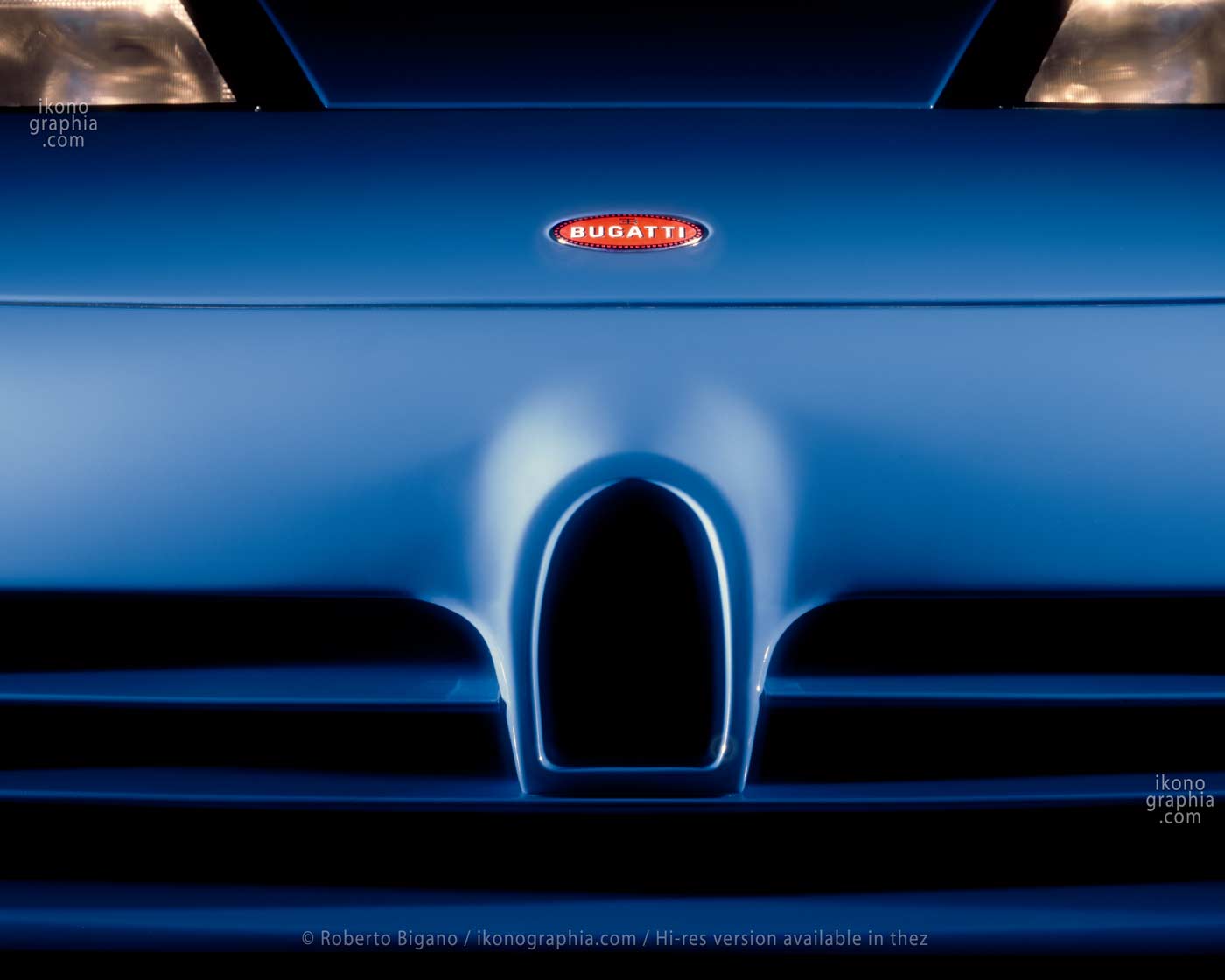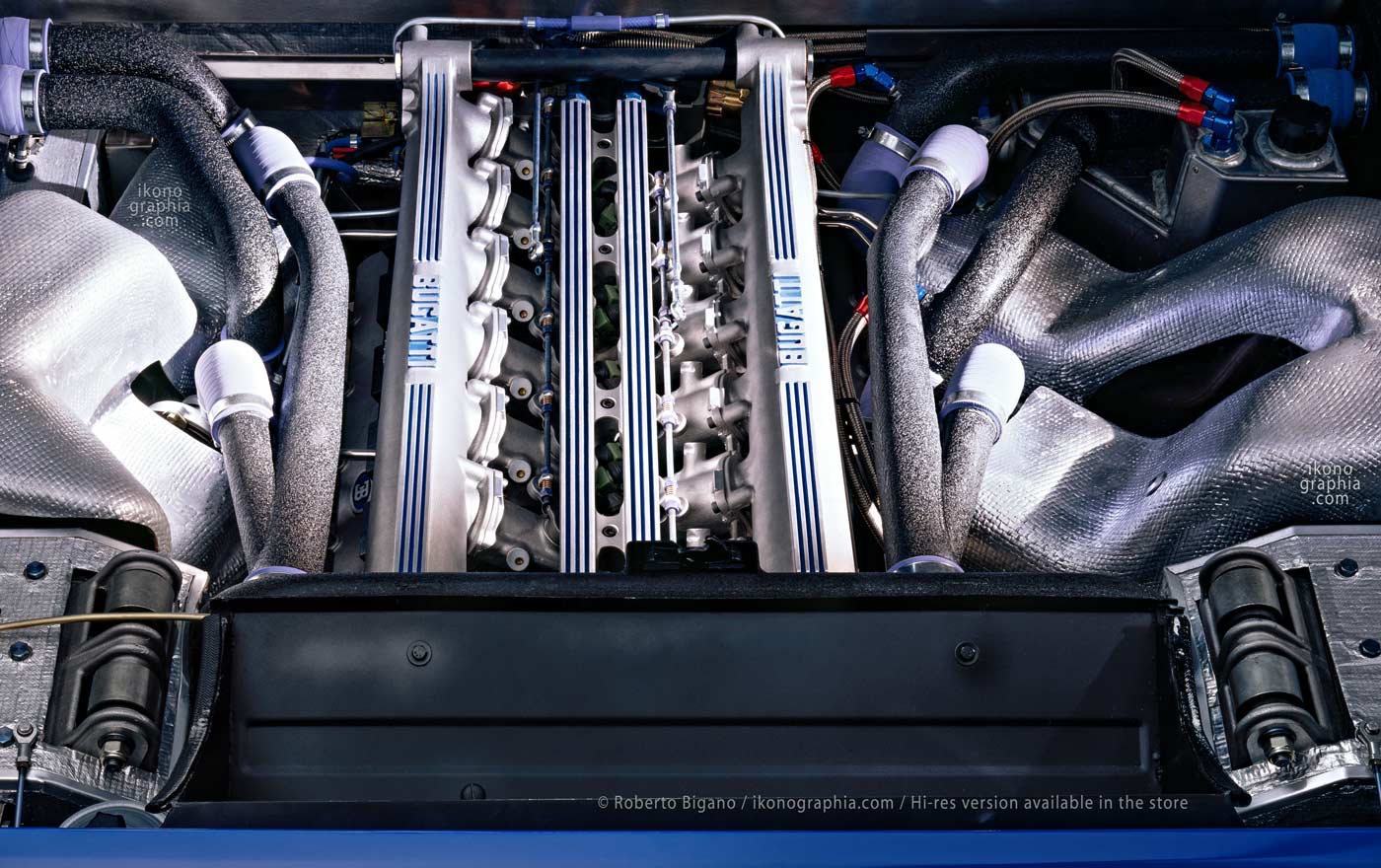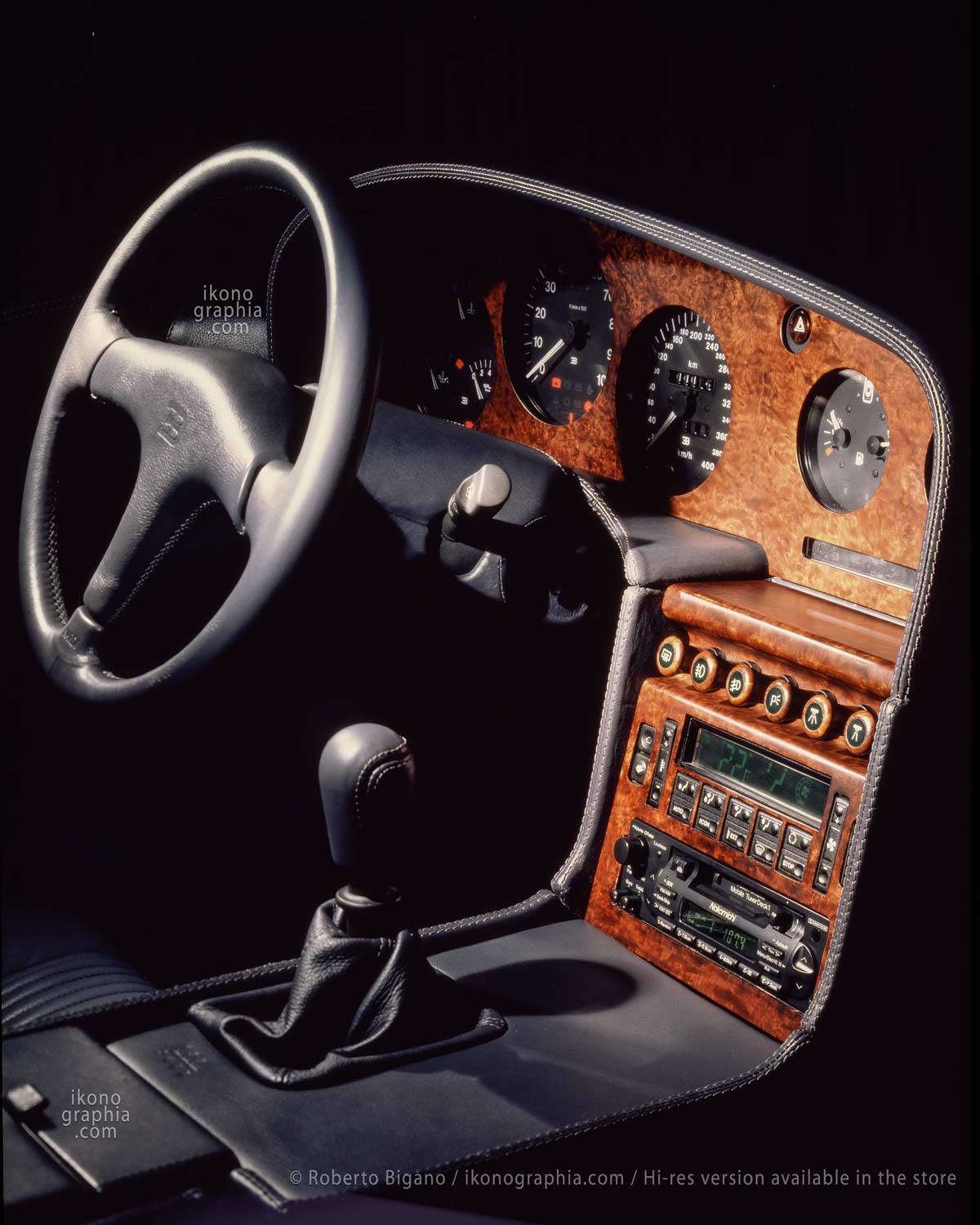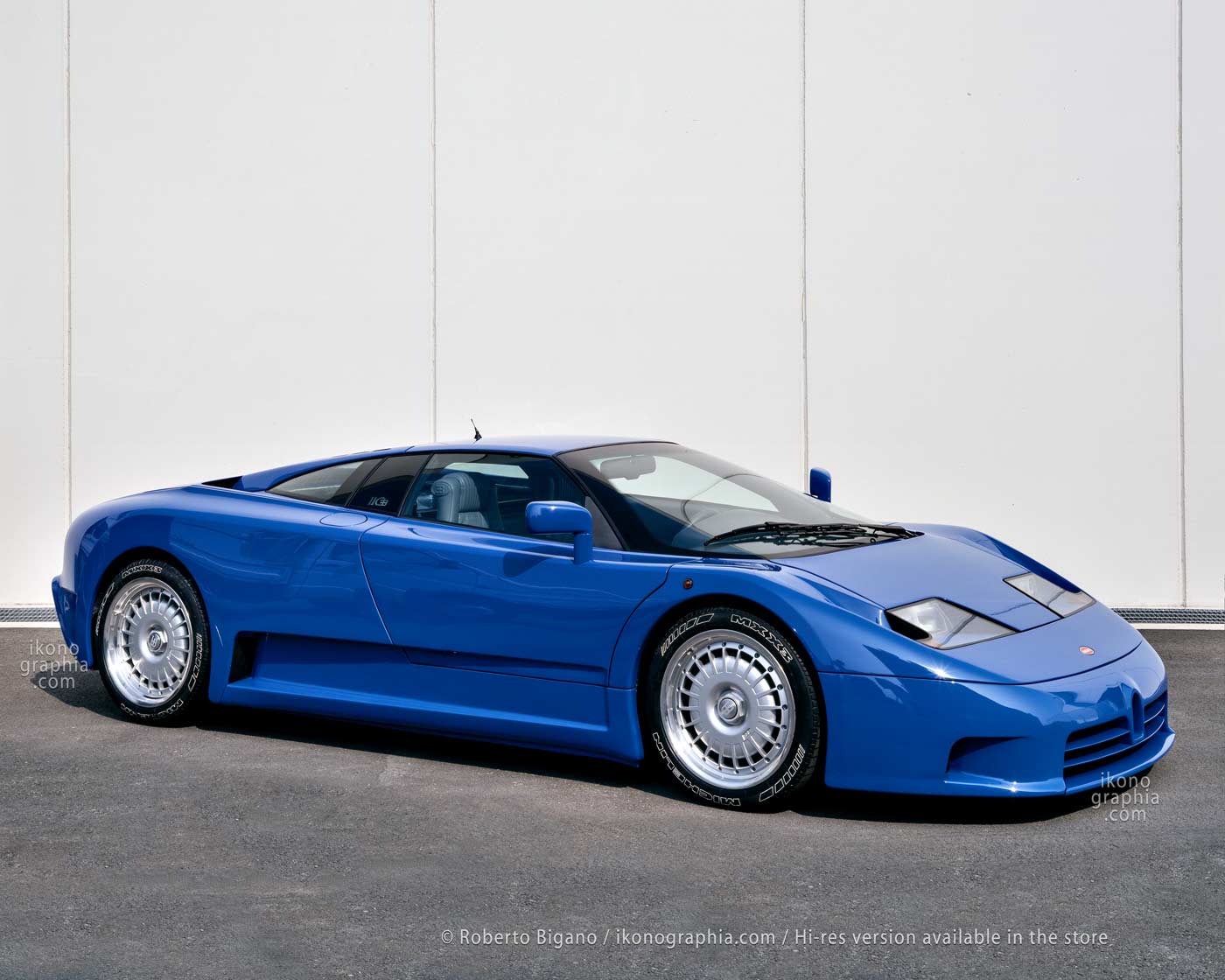Bugatti EB110, First Model, Prototype, EB110 Supersport, EB112

Bugatti Granturismo, as imagined by Romano Artioli.
“This was the project.
The reborn Bugatti had to be the most brilliant Gran Turismo ever built: the most powerful, the fastest, most beautiful, and safest. It had to be a four-wheel drive for the best tractions in all weather conditions and road surfaces.
It had to be lightweight, using superior materials like titanium, magnesium, carbon-fiber, and aluminum for maximum acceleration, shorter braking distance, and best road grip with a lightweight and rigid chassis, for improved safety.
The aerodynamics had to allow optimal penetration and keep the car firmly pressed to the asphalt. Being a Gran Turismo, comfort has to be taken into account. Minimizing noise, designing a well-conditioned and draught-free interior, and a soft and responsive stick shift despite the gears’ weight.”
Excerpt from Romano Artioli’s book “Bugatti & Lotus Thriller.”
The very first EB110 model was made in Epowood as designed by Benedini, with the covered rear wheels reminding of the Bugatti Atlantic.
BUY THE HI-RES FILE
… and re-designed by Gianpaolo Benedini
Romano Artioli chose Paolo Stanzani as Technical Director, because of his work with Lamborghini and Marcello Gandini as Designer. However, Artioli was not impressed by his angular design. Consequently, the conflict led to the respective departure of Gandini and Stanzani.
The role of Technical Director was filled by Nicola Materazzi, a former Chief Engineer at Ferrari.
Gianpaolo Benedini, who designed the “Blue Factory,” was commissioned to redo the design.
Above, the maquette Benedini designed. The design is reminiscent of the classic Bugatti, including the rear-wheel covering.
Leggi in italiano
La Bugatti Granturismo come concepita da Romano Artioli.
Per me la Bugatti della rinascita doveva essere la più brillante Gran Turismo mai costruita: la più potente, la più veloce, la più bella, ma anche la più sicura. Doveva quindi avere quattro ruote motrici, perché mettere su strada un’auto potente e velocissima che non abbia il massimo dell’aderenza in ogni condizione meteorologica e di superficie stradale è un azzardo.
Doveva essere leggera, impiegando materiali speciali come titanio, magnesio, fibra di carbonio, alluminio per favorire la massima accelerazione, il minore spazio di frenata e la massima tenuta di strada. Le sospensioni dovevano garantire la migliore aderenza delle ruote alle strade di qualsiasi tipo.
Inoltre serviva un un telaio rigido, robusto, ma molto leggero, che consentisse una perfetta tenuta di strada.
L’aerodinamica doveva permettere una penetrazione dell’aria ottimale, ma assicurare che l’auto restasse saldamente pressata all’asfalto.
Trattandosi di una GT, anche il comfort era da tenere in considerazione: silenziosità, abitacolo ben condizionato e senza spifferi, condizioni di guida ottimali, una leva del cambio morbidissima e immediata, nonostante il peso degli ingranaggi che dovevano sopportare quelle fortissime pressioni sulla trasmissione e freni che riducessero al minimo le distanze in caso di emergenza.
Questo era il progetto che sottoposi a Oliviero Pedrazzi, e lui partì a razzo…
Estratto da libro di di Romano Artioli “Bugatti & Lotus Thriller.”
… e disegnata da Gianpaolo Benedini
All’inizio Romano Artioli scelse Paolo Stanzani come direttore tecnico, per la sua esperienza con Lamborghini e Marcello Gandini per il design. Purtroppo lo stile troppo “rigido” del suo design non si sposava con lo stile classico Bugatti, cui si voleva fare riferimento.
In breve il conflitto s’opinioni divenne insanabile e Stanzani e Gandini se ne andarono.
Il ruolo di direttore tecnico fu assegnato a Nicola Materazzi, già capo ingegnere alla Ferrari (suo il progetto della F40). Gianpaolo Benedini, che già aveva disegnato “La Fabbrica Blu” fu invece incaricato di ridisegnare l’EB 110. Sopra il risultato del suo lavoro nel primo modello in resina Epowood.
Bugatti EB110 GT Prototipo
Pictured here is the very first version of the EB110 GT, which was very similar to the model shown above except for the rear wheels. The design was changed after Michelin determined that the tires covered would overheat.
Leggi in italiano
Bugatti EB110 GT Prototipo. The very first working EB110.
BUY THE HI-RES FILE
Bugatti EB110 GT
The final version of the EB110 GT, the fastest production GT in the world, capable of reaching 342 kilometers per hour. EB stands for Ettore Bugatti, 110 for the number of years since his birth, and GT for Gran Turismo.
Specifications: 3.5 liters 60-valve quad-turbocharged V12 Bugatti monobloc engine. Permanent four-wheel-drive system. Power output 412 kW / 550hp. 6-speed manual transmission. Carbon fiber body.
Leggi in italiano
La versione finale dell’EB 110, la GT di serie più veloce al mondo, con una velocità massima di 342 km/h. EB sta per Ettore Bugatti, 110 per gli anni dalla sua nascita, e GT per Gran Turismo.
Specifiche tecniche: motore a 12 cilindri a V di 60º, con monoblocco in lega di alluminio e magnesio, testate in alluminio e titanio, sistemato in posizione posteriore centrale longitudinale che ingloba il cambio e parte della trasmissione. Tale propulsore è dotato di lubrificazione a carter secco, distribuzione a due alberi a camme in testa per bancata, con 5 valvole per cilindro. La cilindrata è di 3.500 cm³, alesaggio 81,0 mm e corsa 56,6 mm. Una vera e propria peculiarità dell’auto è di essere dotata di un sistema di sovralimentazione con 4 turbocompressori IHI, caratteristica unica a suo tempo. Eroga una potenza di 412 kXW / 550 CV. Source
The final version of the EB 110 Gran Turismo, the fastest production GT in the world.
BUY THE HI-RES FILE
The Bugatti EB110 GT with raised rear wing
BUY THE HI-RES FILE
Bugatti EB110 Supersport
This performance-oriented Super Sport version had the engine tuned to a maximum power output of 450 kW (612 PS; 612 hp) at 8,250 pm and 650 N⋅m (479 lb-ft) f torque at 4,200 pm. It was lighter and more powerful and with a max speed of 351 km/h. Romano Artioli tells us more:
“The speed performance enthusiasts are willing to give up a few accessories and increase running noise to maximize driving pleasure. Boosting power to 612hp, we removed the radio, air conditioning, and electric window. The front design was the same ff the EB110, while the tailgate was equipped with a fixed-wing, and the air intakes were designed for rough use. The newly brake ventilation, which was necessary for the event of prolonged use on the track.
The interior, in high-quality leather, had been revised to improve functional performance. A lighter polycarbonate replaced the doors crystals and rear window. All these changes reduced the weight of two hundred kilos and gave the car an aggressive image.”
Leggi in italiano
La versione Supersport ottimizzata per prestazioni superiori erogava una potenza massima di 450 kW/61 cavalli. Grazie anche all sua leggerezza raggiungeva una velocità massima di 251 kmh.
Romano Artioli nel suo libro “Bugatti & Lotus Thriller.” ci racconta di più:
Tra gli appassionati d’auto esiste una categoria di cultori delle prestazioni velocistiche che, pur di ottenere sensazioni più forti, è disposta a rinunciare a qualche accessorio e a ridurre la silenziosità di marcia. Per questi è nata la Supersport, che è una EB 110 GT praticamente pronta per la pista.
Incrementata la potenza a 610 CV, eliminammo dalla dotazione di serie radio, condizionatore e vetri elettrici.
Le prese d’aria erano pensate per un uso esasperato della vettura. I cerchi di nuovo disegno consentivano una maggiore ventilazione dei freni, necessaria in caso di uso prolungato in pista. L’interno, sempre in pelle di altissima qualità, era stato rivisto in chiave funzionale alle prestazioni e aveva subito drastici alleggerimenti. I cristalli porta e il lunotto posteriore erano stati sostituiti dal più leggero policarbonato.
Tutti questi interventi, visibili e non, consentirono di diminuire il peso di duecento chili e donarono alla vettura un’immagine aggressiva…
The Bugatti EB110 Supersport. This performance-oriented version reached a max speed of 351km/h.
BUY THE HI-RES FILE
Bugatti EB112
Designed by Giorgietto Giugiaro of Italdesign, the EB112 was a retro-style four-door fastback saloon reminiscent of legendary Bugatti models, such as the Type 57 Atlantic, the masterpiece of “Jean” Gianoberto Bugatti. The body was made entirely of aluminum, with a dedicated carbon-fiber chassis.
The EB112 features a 456 PS (335 kW; 450 hp) V12 engine and a permanent four-wheel-drive system.
Leggi in italiano
Disegnata da Giorgietto Giugiaro di Italdesign, l’EB112 era una lussuosa berlina a quattro porte. Il design riprendeva lo stile dei laggendari modelli Bugatti, prima di tutto l’Atlantic, capolavoro di Gianoberto “Jean” Bugatti.
L’ EB 112 era interamente in alluminio con uno chassis in fibra di carbonio dedicato con una potenza massima di 335kW/450hp, un motore V12 e quattro ruote motrici.
The Bugatti EB 112 Fastback Salooon, designed by Giorgietto Giugiaro.
BUY THE HI-RES FILE
The Bone of Contention
The classic Bugattis had the radiator grill in the front, which was also the symbol of the house. Romano Artioli believed it essential to include a nod to that grill in the EB 110. Gandini was absolutely against it, arguing that he would harm aesthetics and aerodynamics, but Benedini found a brilliant solution.
Leggi in italiano
L’oggetto della discordia.
Le Bugatti classiche avevano sul frontale il radiatore che era il simbolo della casa. Romano Artioli riteneva indispensabile che, anche nell’EB 110 ci fosse un richiamo a quell’elemento. Gandini era assolutamente contrario, sostenendo che avrebbe inciso negativamente su estetica ed aereodinamica. L’architetto Benedini risolse brillantemente il problema.
A detail of the design on the nose reminding the classic Bugatti radiator grill.
BUY THE HI-RES FILE
EB110 GT, EB 110 Supersport, EB 112 images gallery.
A selection of images taken by Roberto Bigano between 1990 and 1992. All images can be purchased in the store.
Leggi in italiano
L’oggetto della discordia.
Le Bugatti classiche avevano sul frontale il radiatore che era il simbolo della casa. Romano Artioli riteneva indispensabile che, anche nell’EB 110 ci fosse un richiamo a quell’elemento. Gandini era assolutamente contrario, sostenendo che avrebbe inciso negativamente su estetica ed aereodinamica. L’architetto Benedini risolse brillantemente il problema.
A striking detail of the nose of the EB 112, with the radiator grill taking inspiration from the classic Bugattis.
BUY THE HI-RES FILE
An impressive view of the Prototype of the Bugatti EB 110 as restyled by Gianpaolo Benedini.
BUY THE HI-RES FILE
The engine of the Bugatti EB 110. Here a different image of the engine.
BUY THE HI-RES FILE
The interior of the Bugatti EB110. In the center of the steering wheel, is the EB logo.
BUY THE HI-RES FILE
The control panel with the briar finishes, the steering wheel with the EB logo, and the Nakamichi hi-fi system.
BUY THE HI-RES FILE
The Bugatti EB 110 rear wheel.
BUY THE HI-RES FILE
The Bugatti EB 110 Gran Turismo. The final version as restyled by Gianpaolo Benedini.
BUY THE HI-RES FILE
The Bugatti EB 110 Gran Turismo. The final version as restyled by Gianpaolo Benedini.
BUY THE HI-RES FILE
The Bugatti EB 110 Gran Turismo. The final version by Gianpaolo Benedini. Rear view.
BUY THE HI-RES FILE
The Bugatti EB110 Supersport in the futuristic showroom at Campogalliano.
BUY THE HI-RES FILE
The front view of the Bugatti EB 112, designed by Giorgetto Giugiaro, with luxury leather finishes.
BUY THE HI-RES FILE
Copyright and credits
Photographs by Roberto Bigano.
All the images in this post are copyrighted. Tutte le immagini di questo post sono coperte da copyright.
Browse and buy all Bugatti Automobili images.
Browse and buy all Bugatti Vintage images.





















